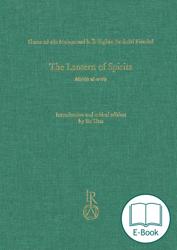Misbâh ul-arvâh, or The Lantern of Spirits, is a comparatively little known Sufi didactic Persian poem written in the 12th century by the next to unknown Shaikh Shams ud-dîn Muhammad b. Îl-Tughân Bardasîrî Kirmânî. It is not a very long poem, covering only 1099 double verses (bait), but it contains both a quite comprehensive compendium of Sufi teachings and a very interesting description of the soul’s journey to the Other World. The latter furnishes fascinating parallels with Dante’s Divina Commedia. The book gives a detailed description of the contents of the poem, with many examples of it’s eloquent verse in translation. The main part of the book, however, gives a critical edition of the Persian text, based on the twelve oldest known manuscripts that contain the poem, the eight oldest of which are dated, making a detailed reconstruction of the original text possible.
Misbâh ul-arvâh, or The Lantern of Spirits, is a comparatively little known Sufi didactic Persian poem written in the 12th century by the next to unknown Shaikh Shams ud-dîn Muhammad b. Îl-Tughân Bardasîrî Kirmânî. It is not a very long poem, covering only 1099 double verses (bait), but it contains both a quite comprehensive compendium of Sufi teachings and a very interesting description of the soul’s journey to the Other World. The latter furnishes fascinating parallels with Dante’s Divina Commedia. The book gives a detailed description of the contents of the poem, with many examples of it’s eloquent verse in translation. The main part of the book, however, gives a critical edition of the Persian text, based on the twelve oldest known manuscripts that contain the poem. Fortunately, the eight oldest of those are dated, and this makes a detailed reconstruction of the original text possible. This reconstruction demonstrates how a strict application of a stemmatic method may be used in the establishment of a 800 years old text. This also makes it possible to follow the textual history of the poem as mirrored in the complete set of variant readings that are given in the apparatus. This work would thus be of particular interest to students and scholars of Classical Persian literature and Sufism as well as those interested in the comparative study of visionary tales of journeys to the Other World.
Bo Utas is Professor Emeritus of Iranian Studies at Uppsala University, Sweden. He got his PhD in Iranian languages from Uppsala University in 1973. In 1981-87 he had a special research position with the Swedish Research council, and in 1988 he was appointed the first professor of Iranian studies in Sweden. His research covers many aspects of Middle and New Iranian languages, especially varieties of Persian, and literary, religious and historical topics connected with the use of those languages. He is a specialist in Persian manuscripts, Sufi texts and Persian metrics. Publications range from his dissertation Tarîq ut-tahqîq. A critical edition, with a history of the text and commentary of 1973 to a collection volume entitled Evidentials. Turkic, Iranian and neighbouring languages (edited together with Lars Johanson) in 2000, and recently the book The virgin and her lover. Fragments of an Ancient Greek Novel and a Persian Epic Poem (= Brill Studies in Middle Eastern Literatures, 30, Leiden 2003; together with Tomas Hägg). Recently his papers on Persian literature were reprinted in a volume entitled: Manuscript, Text and Literature. Collected Essays on Middle and New Persian Texts (= Beiträge zur Iranistik, 29, Wiesbaden 2008), and his linguistic papers in: From Old to New Persian (= Beiträge zur Iranistik, 38, Wiesbaden 2013).
The series Beiträge zur Iranistik was founded in the 1960s by Georges Redard and subsequently edited by Nicholas Sims-Williams from 1997 to 2020; the present series editor is Agnes Korn.
The series publishes works on the languages of the Iranian branch of Indo-European. The focus is on linguistics, including grammars, dictionaries, text editions, philology as well as diachronic and synchronic studies of linguistic topics. Neighbouring fields such as literature, archaeology and anthropology are likewise represented. The languages of the series are English, German and French. The Beiträge zur Iranistik are represented in libraries internationally and are widely used standard works of Iranian studies.


 Preface
Preface